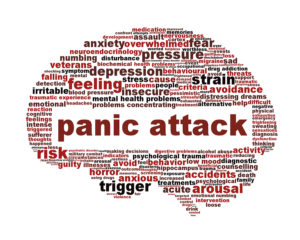AnxietyPath is a safe community environment supported by professional counselors. We are a free self help destination to receive support and guidance for recovery from anxiety and phobias
Understanding What Happens When You Have Panic Attacks
 When we experience a panic attack, it is a result of adrenaline being released into our bloodstream and causing physical sensations that we associate with fear.
When we experience a panic attack, it is a result of adrenaline being released into our bloodstream and causing physical sensations that we associate with fear.
You see, anxiety is our natural self-defense system. It is highly advanced and extremely efficient at doing its job. Anxiety assesses danger, and once it deems something “dangerous” it elicits a response from us in some way. Anxiety is the trigger for the fight or flight mechanism. This mechanism releases adrenaline into our bodies to help us respond faster and stronger than we would under normal conditions.
Originally it was accidentally discovered what effects adrenaline had on people when they did not use it. Years ago the medical community was using adrenaline to help patients with various illnesses. For example, asthma patients would commonly get injections of adrenaline to help alleviate their difficult breathing symptoms. As these patients lay on a table and receive the dose of adrenaline, they experienced various physical symptoms which did not make any sense. There was no rhythm or reason as to how these physical sensations would manifest. These sensations are the exact sensations which are felt during a panic attack. The only difference is that the asthma patient did not associate these sensations with fear, and we do.
When adrenaline is released and used by the body, there are no sensations felt by the person. Take marathon runners for instance; during a long race, the runners release more adrenaline than we experience during a panic attack. But they do not feel any sensations. This is because their bodies are using the adrenaline as it is released and there is no time for the body to do anything else with it.
So back to the way our anxiety works and tries to help us…
So anxiety assesses danger. When it deems something “dangerous”, it kicks into high gear, all in an effort to protect us and allow us to save ourselves. To do this it sends out high levels of anxiety (fear) and triggers the fight or flight mechanism which in turn releases adrenaline. Our natural and automatic response to this combination is to fight or flight; or in simpler terms, “do something”.
This response that we feel is no different than if we were in a serious, life & death, dangerous situation. There is absolutely no difference in the way we experience this fear in a real-life situation, or due to having a panic attack.
An anxiety disorder is our alarm system (anxiety) incorrectly labeling something as “dangerous”. The assessment is the same, the response is the same and its mission in terms of getting us to save ourselves is all the same.
But there is a lot of confusion here for us. Intellectually we know there is no danger. Sure, if I was in a burning building it would make sense for me to go running to save my life. But when I feel like running in a situation where there is no danger present, it makes no sense. And this scares us. This turns the fear into something we cannot understand. We cannot rationalize anxiety disorders. Anxiety disorders are completely irrational, and when we try to rationalize them, it frustrates us and leads us into self-doubt and feeling helpless.
Panic attacks are no more than our natural instincts to protect and/or save ourselves from a dangerous situation.
The duration of a panic attack is typically less than 60 seconds. That’s all it is. Adrenaline is released and it takes less than 60 seconds for the fear to reach its maximum level and for the adrenaline to be absorbed by our bodies.
Even still, the effects of a panic attack can last for literally days later. Not because there is anything physical going on, but rather it is our minds that keep the fear perpetuating long after the panic attack is over. We obsess over the experience and continue to think of it, often worrying about it happening again soon, sometime in the future.
For me personally, I could have a panic attack on a Friday and if asked on Monday how my weekend was I would carry on about how horrible the panic attack was. The panic attack lasted less than 60 seconds, but I obsessed over it for the entire weekend. Ultimately I caused myself more suffering than the actual panic attack did in the first place.
Having a panic attack is the greatest fear a person can experience. There is no way to sugarcoat it or minimize the experience. But the good news is that as we begin to create change in the response to our triggers, panic attacks will come less frequently. And ultimately will stop coming altogether as recovery is made. In addition, there are no long-term negative effects to having panic attacks.
Practice the tools. Never give up. Persistence!
Fear To Fearless
Categories
© 2020 AnxietyPath Powered by G SOUL INC